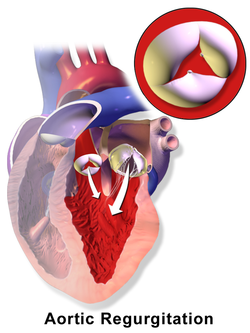Aortic regurgitation: Difference between revisions
CSV import |
No edit summary |
||
| Line 25: | Line 25: | ||
==Pathophysiology== | ==Pathophysiology== | ||
Aortic regurgitation occurs when the aortic valve leaflets fail to close completely during diastole, the phase of the heart cycle when the heart relaxes and fills with blood. This incompetence of the valve allows blood to flow backward from the [[aorta]] into the left ventricle. Over time, this can lead to volume overload of the left ventricle, causing it to dilate and eventually leading to [[heart failure]]. | Aortic regurgitation occurs when the aortic valve leaflets fail to close completely during diastole, the phase of the heart cycle when the heart relaxes and fills with blood. This incompetence of the valve allows blood to flow backward from the [[aorta]] into the left ventricle. Over time, this can lead to volume overload of the left ventricle, causing it to dilate and eventually leading to [[heart failure]]. | ||
==Causes== | ==Causes== | ||
Latest revision as of 16:46, 4 April 2025

Editor-In-Chief: Prab R Tumpati, MD
Obesity, Sleep & Internal medicine
Founder, WikiMD Wellnesspedia &
W8MD medical weight loss NYC and sleep center NYC
| Aortic regurgitation | |
|---|---|

| |
| Synonyms | Aortic insufficiency |
| Pronounce | N/A |
| Specialty | N/A |
| Symptoms | Shortness of breath, fatigue, palpitations, chest pain |
| Complications | Heart failure, endocarditis, arrhythmias |
| Onset | Gradual |
| Duration | Long-term |
| Types | N/A |
| Causes | Rheumatic fever, endocarditis, bicuspid aortic valve, Marfan syndrome, aortic dissection |
| Risks | Hypertension, connective tissue disorders |
| Diagnosis | Echocardiography, chest X-ray, MRI |
| Differential diagnosis | Mitral regurgitation, ventricular septal defect |
| Prevention | N/A |
| Treatment | Medications, surgery |
| Medication | ACE inhibitors, beta blockers, diuretics |
| Prognosis | Variable, depends on severity and treatment |
| Frequency | Common in older adults |
| Deaths | N/A |
A condition where the aortic valve in the heart does not close tightly
Aortic regurgitation (AR), also known as aortic insufficiency, is a condition in which the aortic valve in the heart does not close tightly, allowing some of the blood that was pumped out of the heart's left ventricle to leak back into it. This can lead to a variety of symptoms and complications if left untreated.
Pathophysiology[edit]
Aortic regurgitation occurs when the aortic valve leaflets fail to close completely during diastole, the phase of the heart cycle when the heart relaxes and fills with blood. This incompetence of the valve allows blood to flow backward from the aorta into the left ventricle. Over time, this can lead to volume overload of the left ventricle, causing it to dilate and eventually leading to heart failure.
Causes[edit]
Aortic regurgitation can be caused by a variety of conditions, including:
- Rheumatic fever
- Infective endocarditis
- Aortic dissection
- Marfan syndrome
- Bicuspid aortic valve
- Hypertension
- Degenerative changes in the aortic valve


Symptoms[edit]
Patients with aortic regurgitation may experience a range of symptoms, including:
- Dyspnea (shortness of breath)
- Fatigue
- Palpitations
- Angina (chest pain)
- Syncope (fainting)
Diagnosis[edit]
The diagnosis of aortic regurgitation is typically made using a combination of physical examination, echocardiography, and other imaging techniques. A characteristic finding on auscultation is a diastolic murmur heard best along the left sternal border.
Treatment[edit]
Treatment for aortic regurgitation depends on the severity of the condition and the presence of symptoms. Options include:
- Medical management with vasodilators and diuretics
- Surgical intervention, such as aortic valve replacement
Prognosis[edit]
The prognosis for patients with aortic regurgitation varies depending on the severity of the condition and the timeliness of treatment. Early intervention can improve outcomes significantly.